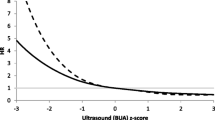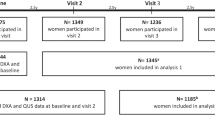Abstract
Summary
Heel ultrasound is a more portable modality for assessing fracture risk than dual-energy X-ray absorptiometry and does not use ionising radiation. Fracture risk assessment requires appropriate reference data to enable comparisons. This study reports the first heel ultrasound reference ranges for the Australian population.
Introduction
This study aimed to develop calcaneal (heel) ultrasound reference ranges for the Australian adult population using a population-based random sample.
Methods
Men and women aged ≥20 years were randomly selected from the Barwon Statistical Division in 2001–2006 and 1993–1997, respectively, using the electoral roll. Broadband ultrasound attenuation (BUA), speed of sound (SOS) and stiffness index (SI) were measured at the heel using a Lunar Achilles Ultrasonometer. Gender-specific means and standard deviations for BUA, SOS and SI were calculated for the entire sample (men 20–93 years, n = 1,104; women 20–92 years, n = 914) and for participants aged 20–29 years (men, n = 157; women, n = 151). Associations between ultrasound measures and age were examined using linear regression.
Results
For men, mean ± standard deviation BUA, SOS and SI were 118.7 ± 15.8 dB/MHz, 1,577.0 ± 43.7 m/s and 100.5 ± 20.7, respectively; values for women were consistently lower (111.0 ± 16.4 dB/MHz, P < 0.001; 1,571.0 ± 39.0 m/s, P = 0.001; and 93.7 ± 20.3, P < 0.001, respectively). BUA was higher in young men compared with young women (124.5 ± 14.4 vs 121.0 ± 15.1 dB/MHz), but SOS (1,590.1 ± 43.1 vs 1,592.5 ± 35.0 m/s) and SI (108.0 ± 19.9 vs 106.3 ± 17.7) were not. The relationships between age and each ultrasound measure were linear and negative across the age range in men; associations were also negative in women but non-linear.
Conclusion
These data provide reference standards to facilitate the assessment of fracture risk in an Australian population using heel ultrasound.


Similar content being viewed by others
References
Bouxsein ML, Radloff SE (1997) Quantitative ultrasound of the calcaneus reflects the mechanical properties of calcaneal trabecular bone. J Bone Miner Res 12(5):839–846
Njeh CF, Hans D, Li J, Fan B, Fuerst T, He YQ, Tsuda-Futami E, Lu Y, Wu CY, Genant HK (2000) Comparison of six calcaneal quantitative ultrasound devices: precision and hip fracture discrimination. Osteoporos Int 11(12):1051–1062
Glüer CC, Wu CY, Genant HK (1993) Broadband ultrasound attenuation signals depend on trabecular orientation: an in vitro study. Osteoporos Int 3(4):185–191
van den Bergh JPW, van Lenthe GH, Hermus ARMM, Corstens FHM, Smals AGH, Huiskes R (2000) Speed of sound reflects Young’s modulus as assessed by microstructural finite element analysis. Bone 26(5):519–524
Bauer DC, Gluer CC, Cauley JA, Vogt TM, Ensrud KE, Genant HK, Black DM (1997) Broadband ultrasound attenuation predicts fractures strongly and independently of densitometry in older women. A prospective study. Study of Osteoporotic Fractures Research Group. Arch Intern Med 157(6):629–634
Moayyeri A, Kaptoge S, Dalzell N, Luben R, Wareham N, Bingham S (2009) The effect of including quantitative heel ultrasound in models for estimation of 10-year absolute risk of fracture. Bone 45(2):180–184
Gluer CC (1997) Quantitative ultrasound techniques for the assessment of osteoporosis: expert agreement on current status. The International Quantitative Ultrasound Consensus Group. J Bone Miner Res 12(8):1280–1288
Henry MJ, Pasco JA, Seeman E, Nicholson GC, Sanders KM, Kotowicz MA (2001) Assessment of fracture risk: value of random population-based samples—the Geelong Osteoporosis Study. J Clin Densitom 4(4):283–289
Pasco J, Nicholson G, Kotowicz M (2011) Cohort profile: Geelong Osteoporosis Study. Int J Epidemiol. doi:10.1093/ije/dyr148
Henry MJ, Pasco JA, Nicholson GC, Seeman E, Kotowicz MA (2000) Prevalence of osteoporosis in Australian women: Geelong Osteoporosis Study. J Clin Densitom 3(3):261–268
Truscott J (1997) Reference data for ultrasonic bone measurement: variation with age in 2087 Caucasian women aged 16–93 years. Br J Radiol 70(838):1010–1016
Kastelan D, Kujundzic-Tiljak M, Kraljevic I, Kardum I, Giljevic Z, Korsic M (2006) Calcaneus ultrasound in males: normative data in the Croatian population (ECUM study). J Endocrinol Invest 29:221–225
Hinkley HJ, Drysdale IP, Walters NJ, Bird D (2004) Normative data for ultrasound measurement of the calcaneus within different female ethnic groups. Br J Radiol 77(921):740–744
Sosa M, Saavedra P, Munoz-Torres M, Alegre J, Gomez C, Gonzalez-Macias J (2002) Quantitative ultrasound calcaneus measurements: normative data and precision in the Spanish population. Osteoporos Int 13(6):487–492
Trovas G, Tsekoura M, Galanos A, Dionyssiotis Y, Dontas I, Lyritis G, Papaioanou N (2009) Quantitative ultrasound of the calcaneus in greek women: normative data are different from the manufacturer’s normal range. J Clin Densitom 12(3):353–359
Landin-Wilhelmsen K, Johansson S, Rosengren A, Dotevall A, Lappas G, Bengtsson BA, Wilhelmsen L (2000) Calcaneal ultrasound measurements are determined by age and physical activity. Studies in two Swedish random population samples. J Intern Med 247(2):269–278
Langton C, Langton D (1997) Male and female normative data for ultrasound measurement of the calcaneus within the UK adult population. Br J Radiol 70(834):580–585
Lim YW, Chan L, Lam KS (2005) Broadband ultrasound attenuation reference database for Southeastern Asian males and females. Ann Acad Med Singapore 34(9 Supp):545–547
Saadi HF, Reed RL, Carter AO, Dunn EV, Qazaq HS, Al-Suhaili AR (2003) Quantitative ultrasound of the calcaneus in Arabian women: relation to anthropometric and lifestyle factors. Maturitas 44(3):215–223
Zhu Z-Q, Liu W, Xu C-L, Han S-M, Zu S-Y, Zhu G-J (2008) Reference data for quantitative ultrasound values of calcaneus in 2927 healthy Chinese men. J Bone Miner Metab 26(2):165–171
Heldan de Moura Castro C, Medeiros Pinheiro M, Lúcia Szejnfeld V (2000) Quantitative ultrasound of the calcaneus in Brazilian Caucasian women: normative data are similar to the manufacturer’s normal range. Osteoporos Int 11(11):923–928
Pye S, Devakumar V, Boonen S, Borghs H, Vanderschueren D, Adams J (2010) Influence of lifestyle factors on quantitative heel ultrasound measurements in middle-aged and elderly men. Calcif Tissue Int 86(3):211–219
Jokinen H, Pulkkinen P, Korpelainen J, Heikkinen J, Keinanen-Kiukaanniemi S, Jamsa T (2010) Risk factors for cervical and trochanteric hip fractures in elderly women: a population-based 10-year follow-up study. Calcif Tissue Int 87(1):44–51
Kanis JA, Johnell O, Oden A, Johansson H, McCloskey E (2008) FRAX and the assessment of fracture probability in men and women from the UK. Osteoporos Int 19(4):385–397
Henry MJ, Pasco JA, Sanders KM, Nicholson GC, Kotowicz MA (2006) Fracture Risk (FRISK) Score: Geelong Osteoporosis Study. Radiology 241(1):190–196
Nguyen ND, Frost SA, Center JR, Eisman JA, Nguyen TV (2008) Development of prognostic nomograms for individualizing 5-year and 10-year fracture risks. Osteoporos Int 19:1431–1444
Pasco JA, Sanders KM, Hoekstra FM, Henry MJ, Nicholson GC, Kotowicz MA (2005) The human cost of fracture. Osteoporos Int 16(12):2046–2052
Randell A, Sambrook PN, Nguyen TV, Lapsley H, Jones G, Kelly PJ, Eisman JA (1995) Direct clinical and welfare costs of osteoporotic fractures in elderly men and women. Osteoporos Int 5(6):427–432
Anonymous (2003) Prevention and management of osteoporosis. World Health Organ Tech Rep Ser 921:1–192
Henry MJ, Pasco JA, Korn S, Gibson JE, Kotowicz MA, Nicholson GC (2010) Bone mineral density reference ranges for Australian men: Geelong Osteoporosis Study. Osteoporos Int 21(6):909–917
Acknowledgements
The study was funded by the National Health and Medical Research Council (NHMRC), Perpetual Trustees and Geelong Region Medical Research Foundation. Dr. Sharon Brennan is the recipient of an NHMRC Early Career Fellowship (1012472).
Conflicts of interest
None.
Author information
Authors and Affiliations
Corresponding author
Rights and permissions
About this article
Cite this article
Gould, H., Brennan, S.L., Nicholson, G.C. et al. Calcaneal ultrasound reference ranges for Australian men and women: the Geelong Osteoporosis Study. Osteoporos Int 24, 1369–1377 (2013). https://doi.org/10.1007/s00198-012-2082-y
Received:
Accepted:
Published:
Issue Date:
DOI: https://doi.org/10.1007/s00198-012-2082-y




